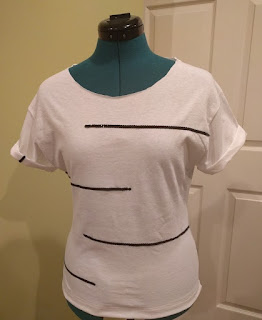
A staple for your closet! A silk camisole looks amazing under a blazer or by itself, with pants, jeans, or a skirt. Black is universal. You can make this in any color, but black goes with everything.
Supplies:
- Pattern paper
- Ruler
- Measuring Tape
- Scissors
- Pins
- 1 Yard Silk or Satin Material
- 1 Yard Black Rattail Cord
- Black Thread
- Sewing Machine
 |
| Figure A |
Make Your Pattern:
(Refer to Figure A)
1. Use the measuring tape on yourself to obtain the following measurements: Measurement C is the bottom of your V-neck to where you want your camisole to end.
2. Measurement E is your hip measurement divided by 4, plus 1 inch. Draw this line perpendicular to C.
3. Measurement A is the distance from where you put the bottom of your V-neck to where your straps will go.
4. Measurement D is the top of your camisole, where the straps will connect, to the bottom of your camisole.
5. Starting from the top of line C, measure over the distance of A and mark this spot with a dot (this is a placeholder). Next, measure up from line E, intersecting your dot, the distance of Measurement D. This is the location of where your straps will connect.
6. Draw a line from the top of line A to the top of your camisole where your straps will connect (found in Step 5).
7. For Measurement B, start at the top of line A (the bottom of your V-neck) and drop down to where you want the bottom of your armhole. For me, this was 2 inches. This is approximate. Eyeball where the top will wrap around. Next, take your bust measurement divided by 4, and add 1 inch. Measure this far over from the point you just found on line A; this is the bottom of your armhole.
8. Draw a line from the bottom of your armhole to the top and bottom of your camisole as shown in Figure A. Optional: You can curve the armhole line if desired, but be careful not to overdo it or you'll have major side-boob.
9. Add seam allowance to your pattern; I used 1/2 inch and 1 inch at the bottom for the hem. *Note: Line C is a fold line; you don't need to add seam allowance here.
Directions:
Note: I suggest making a muslin first and altering pattern as needed before cutting your good fabric.
1. Cut 2 on fold (line C) of pattern. Cut 2 facings using the same pattern, but stop halfway down (gray line in Figure A).
NOTE: you can easily make your back flat instead of a V shape by following the instructions in my Silky Black Camisole with Lace tutorial.
NOTE: you can easily make your back flat instead of a V shape by following the instructions in my Silky Black Camisole with Lace tutorial.
2. With right-sides together, sew facings to front and back pieces at neckline and armhole. (Do not sew side seams!)
Note: If using stretchy material, stay-stitch the neckline first in a directional manner. This means, stitch close to the edge (within the seam allowance) starting at the bottom of the V and going up on both sides. This is done to prevent stretching while sewing your garment.
3. Snip into the seam allowance at the bottom of your V, careful not to cut into the stitches. Grade your seam allowance by trimming down one side (this prevents bulky seams), trim around the points of where your straps will attach, and snip triangle pieces from your armhole if it is curved.
4. Invert, push out points, and press.
5. Now is time to finish the bottom of your facings. You can zig-zag stitch, serge, or, if it doesn't fray, leave it as is.
6. Baste the sides of your facings to your camisole.
7. Right-sides together, sew front and back pieces together at side seams. Finish seams. Press.
8. Edge stitch all the way around top of camisole. (Note: if you don't want to see any stitches on the outside, you will have to stay-stitch your neckline instead. To do this, you sew your facing to the seam allowance; this keeps the facing from rolling out and showing.)
9. Measure how much Rattail cord you will need for your straps. To do this, I suggest trying your camisole on and deciding how far down you want it to hang.
10. Hand sew straps in place.
11. Hem bottom of camisole.
Done!
I know it seems like a lot of steps, but this is actually a very simple project. And it's inexpensive. I got my satin from the remnant section at Joann's for only $4.25! It is usually $6.49/yard (still super cheap). The Rattail cording is only $0.73/yard.
Total cost of project: $4.98!
Tip: Change it up by adding lace to the neckline or bottom edge. Now that you have a pattern, you can make it again and again!










































